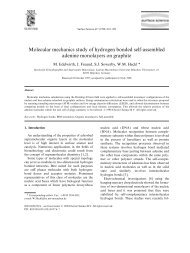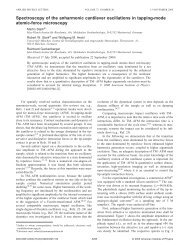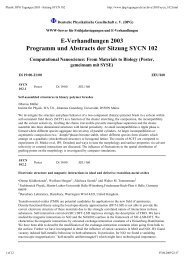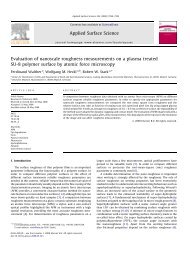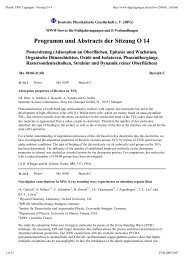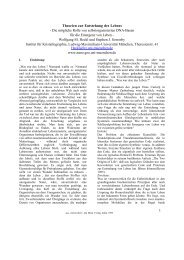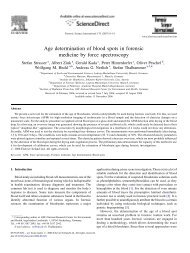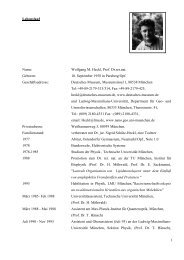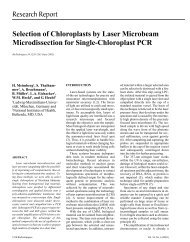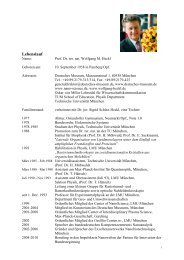Physik: DPG Tagungen - Sitzung O 28 - Nano-science.de
Physik: DPG Tagungen - Sitzung O 28 - Nano-science.de
Physik: DPG Tagungen - Sitzung O 28 - Nano-science.de
Create successful ePaper yourself
Turn your PDF publications into a flip-book with our unique Google optimized e-Paper software.
<strong>Physik</strong>: <strong>DPG</strong> <strong>Tagungen</strong> - <strong>Sitzung</strong> O <strong>28</strong><br />
http://www.dpg-tagungen.<strong>de</strong>/archive/2004/o_<strong>28</strong>.html<br />
Max-Planck-Institut für Festkörperforschung, Heisenbergstraße 1, 70569 Stuttgart<br />
Despite the significance of SiC for high-temperature and high-power electronic <strong>de</strong>vices based on<br />
metal/semiconductor interfaces, the initial stages of metal layer formation on SiC surfaces still remain<br />
insufficiently explored in comparison to well known metal/silicon heterointerfaces, such as Ag on Si. We<br />
investigated the <strong>de</strong>position of Ag on 4H-SiC(0001) using quantitative low-energy electron diffraction (LEED).<br />
Ag layers of 0.2, 0.5 and 1 ML coverage were <strong>de</strong>posited on the clean (3×3) and (?3×?3)R30 ? SiC(0001) surface<br />
phases. The structural <strong>de</strong>velopment after room temperature <strong>de</strong>position as well as after annealing was studied.<br />
The (3×3) phase is only marginally influenced by Ag <strong>de</strong>position at room temperature. Annealing leads to Ag<br />
diffusion and subsequent <strong>de</strong>sorption without a significant phase transformation. In case of the (?3×?3)R30 ?<br />
phase consi<strong>de</strong>rable changes can be monitored in the LEED intensities spectra immediately after <strong>de</strong>position. Here,<br />
structural changes are found during annealing also, possibly caused by Ag diffusion. In both cases the original<br />
surface phases reappear after Ag <strong>de</strong>sorption.<br />
O <strong>28</strong>.24 Poster Mi 16:00 Bereich C<br />
High temperature stable silici<strong>de</strong> contacts on the nanometer scale<br />
•G. Gardinowski, C. Tegenkamp, T. Block, S. Vagt, V. Zielasek und H. Pfnür<br />
Institut für Festkörperphysik, Universität Hannover, Appelstrasse 2, 30167 Hannover<br />
In or<strong>de</strong>r to characterize nanostructure electrically contacts are essential to build a bridge between the macrospic<br />
and the mesoscopic world. High temperature experiments with nanostructures on silicon substrates are<br />
particularly interesting, but require contacts which can withstand temperatures up to 1100 ? C without changes in<br />
their chemical composition and without interdiffusion at the contact area of the silici<strong>de</strong> and the silicon. Using<br />
electron beam lithography different silici<strong>de</strong> contacts on both Si(111) and Si(100) surfaces have been fabricated<br />
and tested. With regard to the specific formation temperatures for silici<strong>de</strong>s, mainly Mo, Ta and Ti have been<br />
tested. All three silici<strong>de</strong>s are stable up to at least 800 ? C. The metallic character of the silici<strong>de</strong>s was tested by<br />
masurements of the conductivity. However, for higher temperatures the <strong>de</strong>composition of MoSi 2 and TaSi 2 sets<br />
in leaving behind rough contact areas. Only the TiSi 2 silici<strong>de</strong> remains intact, as checked by µ-Auger<br />
spectroscopy. Furthermore, after optimization of the lithography parameters, TiSi 2 contact pads with separation<br />
lengths of 200 nm were fabricated successfully, i.e. after removing the native oxi<strong>de</strong> from the silicon surface<br />
(with pads) by a high temperature annealing step, perfect silicon was found in between the contacts as seen by<br />
STM/SEM. The edges of the contacts are rather sharp and well-<strong>de</strong>fined. The transition area was <strong>de</strong>termined to<br />
be around 1nm.<br />
O <strong>28</strong>.25 Poster Mi 16:00 Bereich C<br />
Direct evi<strong>de</strong>nce from FTIR for hydrogen incorporation into the MOCVD-grown P-rich reconstructed<br />
InP(100) surface<br />
•Tobias Letzig, H.J. Schimper, Thomas Hannappel und Frank Willig<br />
Hahn-Meitner-Institute, Glienicker Str. 100, 14109 Berlin, Germany<br />
Recently, the groups of Schmidt and Bechstedt have discussed several different surface reconstructions for<br />
InP(100). Three of those have been assigned to actually prepared surface reconstructions. In the case of<br />
MOCVD growth the P-rich (2x1/2x2) surface is postulated to contain hydrogen bonds that stabilize buckled P-P<br />
dimers. A P-rich surface with a different reconstruction is formed via MBE growth in the absence of hydrogen.<br />
The In-rich (2x4) reconstruction also does not contain any hydrogen atoms. We present here experimental<br />
support for the postulated hydrogen bonds on the surface of MOCVD grown P-rich (2x1/2x2) reconstructed<br />
InP(100) in the form of FTIR spectra that were measured in UHV. We ma<strong>de</strong> use of a patented contamination<br />
free transfer of the sample from the MOCVD reactor into a mobile UHV chamber. FTIR spectra will be<br />
presented for the as-grown surface and for the surface after further exposure to hydrogen and <strong>de</strong>uterium.<br />
O <strong>28</strong>.26 Poster Mi 16:00 Bereich C<br />
9 of 32 07.06.2009 22:14



